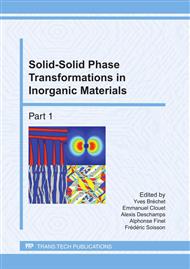p.1140
p.1146
p.1156
p.1164
p.1171
p.1177
p.1183
p.1189
p.1195
Thermodynamic Modelling of Carbide Precipitation in Hot Work Tool Steels with Different Silicon Contents
Abstract:
New grades have been developed in high alloy tool steels, enabling improved mechanical properties by modifications on Si, Cr or Mo contents. The correlation between alloy modifications and mechanical properties were successively correlated to microstructural aspects in previous work, especially in terms of secondary hardening carbides. In the present paper, thermodynamic and kinetic simulations were carried out and correlated to these data, especially in terms of Si effect on M3C carbide precipitation. Free energy evaluation points to easier formation of M7C3 carbide in high Si steels, especially at high tempering temperatures, which are typical for hot work tool steels. Kinetic evaluations, based on the present simulations and literature, also show that cementite formation is retarded in high Si steels, which also lead to direct formation of M7C3. Regarding the low Si steels, cementite enrichment by Cr, Mo and V was also evaluated in terms of simulation. The results are in good agreement and help the explanation on the slower dissolution of cementite particles in low silicon steels, leading to important implications to the higher tempering resistance of these grades. Therefore, tempering simulation on the new hot work tool steel compositions aided the understanding of the microstructure modifications found experimentally.
Info:
Periodical:
Pages:
1171-1176
Citation:
Online since:
June 2011
Keywords:
Price:
Сopyright:
© 2011 Trans Tech Publications Ltd. All Rights Reserved
Share:
Citation:


